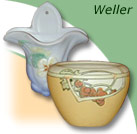|
|

Weller Pottery
Sam Weller founded Weller Pottery in 1872. The pottery was originally started in Fultonham, Ohio as a one-man shop. The initial products made by Weller pottery were utilitarian ware such as flowerpots and cookware. In 1888, Samuel Weller moved Weller pottery to Zanesville, Ohio.
Weller pottery began to make art pottery in 1885. The first art pottery line produced by Weller pottery was Louwelsa. Other early art pottery lines introduced by Weller pottery include Dickensware, Eocean, and Floretta. Weller potttery’s Eocean, Louwelsa, and Dickensware remain extremely popular with today’s American art pottery collectors.
One of Weller pottery’s most popular patterns is Hudson. The Weller Hudson line was developed in the late twenties near the end of the era of hand crafted and decorated art pottery. The Weller Hudson line was characterized by shaded pastel backgrounds decorated with floral and sometimes scenic designs in heavy slip. Weller pottery produced several variations of Hudson including Blue and Decorated, White and Decorated, Perfecto, Rochelle, and Delta. Notable Weller pottery artists such as Hester Pillsbury, Claude Leffler, Dorothy England, Sarah Timberlake, Mae Timberlake, and Sarah McLaughlin often signed Hudson examples.
Weller pottery was one of the last American art pottery companies to produce hand-decorated pottery. Weller Bonito, Geode, and Stellar were among the last hand-decorated patterns produced by the Weller pottery company. By the mid 1930s, Weller pottery could no longer economically produce handcrafted art pottery and from that point on focused only molded pottery. As with most other American art pottery companies, Weller’s quality went down after the mid 1930s. Weller pottery went out of business in 1948.
Throughout its existence, Weller pottery was marked with a variety of trademarks. Weller pottery was not as consistent with its markings as other American art pottery companies such as Rookwood or Roseville pottery. It is not at all unusual to find inconsistencies in the marks seen on most Weller pottery patterns. Some of the more recognized marks used by Weller pottery include the impressed die-stamp WELLER mark which was used from around the late 1900s to prior to 1925. Other familiar Weller pottery marks include the full and half kiln Weller Pottery ink stamps. These ink stamps were used during the 1920s. Later examples of Weller Pottery are often marked with an in-mold script mark.
Shop our preferred Weller Pottery Dealer
© 2003-2014 Roseville-Pottery-Plus.com | All rights reserved